By Alan Gilchrist ZL4PZ
My First 12 Months as a Ham
I had purchased my first equipment from Peter Dalliessi ZL4MS who held the YAESU franchise at Radio Engineering in McBride Street, Dunedin. I bought a YAESU FT-227R 2 metre FM mobile rig and an FT-101E High Frequency (HF) transceiver for later capability of making contact with overseas amateur stations as well as those throughout New Zealand.
My log book shows that my first contact on 2 metres was with Keith Shore ZL4AI via our local Channel C repeater on Mt. Cargill. This was at 2.30pm on 24th November 1978. This contact was followed shortly afterwards by one with Brenda ZL4TIL, Keith's wife, who also sat the same exam as myself. The next contact was with Phil ZL4GP who as previously mentioned had been the one responsible for getting me started on the journey to amateur radio in the first place. I had 10 contacts that day, the start of many more enjoyable encounters with fellow amateurs not only in Dunedin but eventually around the world. I should mention that my 2 metre rig was fitted to my station wagon which was supplied by my employer. It shared the vehicle with my CB set and the firm's radio telephone. Gee! Three microphones to choose from now, and YES, I did make a mistake a couple of times and tell the Group Rental staff that "ZL4TIM is listening on Channel C"! I think I may have also called the 'office' on 2 metres also. Oh well, I probably wasn't the first and won't be the last.
My callsign of ZL4TIM was only to be 'aired' for a matter of around 27 days as I had already booked in for my morse test again for the first Wednesday in December, this being the day that these tests were carried out by the NZ Post Office for amateur operators. The day came and the test was duly done, and although still far from calm about the whole thing I passed without problem. I think the gentlemen in that office must have been wanting to get everything sorted out and a clean desk for the holidays as my certificate and new callsign arrived before Christmas, on 21st December 1978. I was now to be known as ZL4PZ, (ZL4 Papa Zulu).
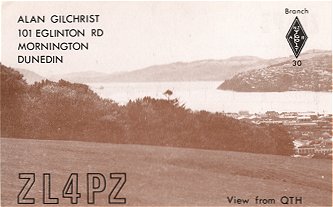 This was a great improvement on the previous grade of licence as I was now able to use the 80 metre band, with frequencies between 3.500 MHz and 3.900 MHz, thus extending my range of communication greatly. The purchase of our property at 101 Eglinton Road was not the wisest move in hind sight. The ZL4PZ QSL card with view from Eglinton Road is shown at right. Mind you, I wasn't 'into' amateur radio at that time and being on a hill over the city was pretty good for signals on CB. The down side was later found to be the presence of dreadful interference emanating from the power lines passing directly outside causing me to think there was no such thing as contact with the upper half of the North Island on the 80 metre band. It wasn't till we moved to Flaxmere in Hastings that I found extreme quiet on this band mainly due to underground mains wiring.
This was a great improvement on the previous grade of licence as I was now able to use the 80 metre band, with frequencies between 3.500 MHz and 3.900 MHz, thus extending my range of communication greatly. The purchase of our property at 101 Eglinton Road was not the wisest move in hind sight. The ZL4PZ QSL card with view from Eglinton Road is shown at right. Mind you, I wasn't 'into' amateur radio at that time and being on a hill over the city was pretty good for signals on CB. The down side was later found to be the presence of dreadful interference emanating from the power lines passing directly outside causing me to think there was no such thing as contact with the upper half of the North Island on the 80 metre band. It wasn't till we moved to Flaxmere in Hastings that I found extreme quiet on this band mainly due to underground mains wiring.
With the previous restricted licence and using only 2 metres (144-148 MHz) contacts were only possible over a limited range even from a hilltop such as Mt.Cargill you were lucky to reach someone in Christchurch. Repeaters provided some advantages and allowed contacts to be made while you were mobile in your car or even by using a handheld transceiver you could talk to others who were in Ashburton for instance. A repeater is generally sited at some prominent hill or mountain where signals can be heard from a long distance away. What happens is this, you transmit on a particular frequency, say 146.300 MHz, and this transmission is received by a 'repeater' on the hill. The 'repeater' in turn sends the same transmission out again but on a sightly different frequency, shifted upwards in this case by 600kHz to 146.900 MHz. [You see, you can't actually send it back out on the same frequency as it would be in turn received again by itself (the repeater) and chase it's tail so to speak, it would recirculate. If this happened all sorts of nasty things would happen to your words and everything would lock up.] So, your signal would be transmitted out on 146.900 MHz and the other person would receive it if he/she was tuned to it correctly. They would have their equipment tuned so that the transmit and receive frequencies were separated by 600 kHz, but in the opposite way round to the repeater. It all sounds a bit complicated doesn't it but basically the transmit and receive frequencies used by an operator are the opposite way around to those of the repeater. This arrangement works extremely well and is of course similar to that used by commercial organisations for radio-telephones in taxis and other businesses.
So, getting back to High Frequencies (HF) this is a completely different ball game. At this stage of course operating on HF was a bit of a mystery. I once again called on the expertise of Phil ZL4GP who allayed any fears I had about 'blowing the finals' due to incorrect 'tuning up' procedures. Almost without fail contacts are made on what is known as 'simplex', in other words the same frequency is used to transmit and receive. These days transmissions are generally on Single Side Band (SSB) although there are still other modes available such as Frequency Modulation (FM), Amplitude Modulation (AM) and Continuous Wave (CW) or morse code.
The benefits of morse code. Yes, that morse code stuff. You don't actually have to use it but having spent all those hours learning it to pass your test it is just as well to try that mode for a contact with someone. You see, in some of the under-developed countries they have little in the way of more sophisticated radio equipment with facilities such as SSB or AM, so the only way you are going to contact them is with morse code (or CW as it is known).  There is another very good reason why morse code is important when you are seeking a contact with other countries. You see not everyone in this world of ours speaks English, strange that. However, to the rescue comes morse code and a heap of abbreviations as used by telegraphists of years gone by. They had a way of shortening their messages by using another code called the 'Q' code . They would send these abbreviations, all starting with 'Q' which would generally be sent as a question or a response! Real cunning eh, these old geezers really had a few clues when you think if it. This is what would happen.
There is another very good reason why morse code is important when you are seeking a contact with other countries. You see not everyone in this world of ours speaks English, strange that. However, to the rescue comes morse code and a heap of abbreviations as used by telegraphists of years gone by. They had a way of shortening their messages by using another code called the 'Q' code . They would send these abbreviations, all starting with 'Q' which would generally be sent as a question or a response! Real cunning eh, these old geezers really had a few clues when you think if it. This is what would happen.
If the person at one end was sending too fast for easy copy, the other operator would send 'QRS' which meant 'please send more slowly', alternatively 'QRQ' means 'please send more quickly'. A question mark of course would turn it into a question such as "QRQ ?' to signify 'shall I send more quickly'.
Of course, this now brings us to another subject or subjects, QSL cards and signal reports. QSL cards are cards confirming a contact with another station. 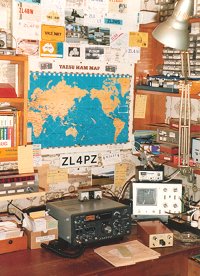 There are more than one reason for wanting a QSL card from another station. Firstly, they look nice up on the wall or in a book, but they are a written confirmation that you did in fact have a two-way contact with that station in that country. There are awards and certificates for those who contact certain numbers of countries or totals of contacts in one country or area. Some of these like DXCC require that you actually hold QSL cards from each of those countries before a certificate will be issued. DXCC basically means contacts with 100 different DX (Distant) countries. I won't go into the rules on things like this but some find this sort of thing a real challenge. QSL cards are sent out by overseas Broadcast Radio stations to 'shortwave listeners' who send them reports on how good their signals were received. One of these is HCJB in Quito, Equador. There is a group known as the Radio DX League who are interested only in listening to foreign stations, and generally getting QSL cards from them in return for their reports. Arthur Cushen of Invercargill, who died in September 1997, was known world wide as an authority on DX and his disability of blindness in no way lessened his interest in that hobby. Eglinton Road shack with FT-101ZD rig is shown at left.
There are more than one reason for wanting a QSL card from another station. Firstly, they look nice up on the wall or in a book, but they are a written confirmation that you did in fact have a two-way contact with that station in that country. There are awards and certificates for those who contact certain numbers of countries or totals of contacts in one country or area. Some of these like DXCC require that you actually hold QSL cards from each of those countries before a certificate will be issued. DXCC basically means contacts with 100 different DX (Distant) countries. I won't go into the rules on things like this but some find this sort of thing a real challenge. QSL cards are sent out by overseas Broadcast Radio stations to 'shortwave listeners' who send them reports on how good their signals were received. One of these is HCJB in Quito, Equador. There is a group known as the Radio DX League who are interested only in listening to foreign stations, and generally getting QSL cards from them in return for their reports. Arthur Cushen of Invercargill, who died in September 1997, was known world wide as an authority on DX and his disability of blindness in no way lessened his interest in that hobby. Eglinton Road shack with FT-101ZD rig is shown at left.
I digress from the track, so had best get back on it. December 20th was my last logged contact on 2 metres before passing that dreaded morse test. My first contact on 80 metres was with Phil ZL4GP at 2047hrs NZDT (8.47 PM) on 21st December 1978 using a frequency of 3.712 MHz. After chatting for some time we went down in frequency to 3.540 MHz and commenced my first ever actual CW contact on air. My log says it lasted 13 minutes.
Contacts on 80 metres were a little bit spasmodic at first, I wasn't one to jump in and make a fool of myself. There's a good saying that goes something like "open your ears before you open your mouth and put your foot in it". It's a pity some of our new amateurs didn't know about that saying.
On Christmas eve I made contact with someone with whom I became good friends over the following years in ham radio. Vern ZL4NAE and myself had a contact on CW (morse) at 7.40 PM and over the next few months we had many contacts in that mode. Vern was the holder of a Novice licence at that time, having passed 6 words per minute in his morse test. In those days the Novice licence was only valid for 12 months and did not allow use of the 2 metre band. Vern later upgraded his technical qualifications to obtain a Limited or Technician licence which at that time required he hold two separate callsigns, one for use on each of his allocated bands. He used ZL4TJN while on 2 metres and ZL4NAE on the novice section of 80 metres. Vern later passed his 12 words per minute and gained his ZL4JN callsign.
As I mentioned earlier, and my log book confirms this, contacts with stations north of the ZL2 area (Wellington region) did not become part of my coverage from our home in Eglinton Road. This was due to the excessive interference from power lines outside our house. However, I did manage to 'work' Neville VK2QF in Hargrove NSW, (Australia) who had also been on air about the same time. Following that contact I was called by Alan VK3NCH, a novice, who lived in Orbost, Victoria. There was DX to be had from Eglinton Road after all ! Over the following months I worked other VK districts and Chris ZL1BIQ/K who was on the Kermadec Islands at the Met. Station was contacted on 25th February 1988.
It must have been around this time when I got involved in the Awards Net, sometimes known as the Counties Net. This was a Net (gathering of people on radio) specifically organised to provide amateurs with a frequency on which to meet for the purpose of exchanging information that was required for certain awards. First, I'll tell you about awards. They are fancy certificates to adorn your wall or other place. You obtain these awards by fulfilling certain criteria then sending off some cash to the appropriate person together with a list. The list is of information on those stations you have contacted specifically relating to that award. Typically you might need to contact say 25 Christchurch amateurs and send a list of these to the Christchurch club with a few dollars to receive a colourful picture of Christchurch overprinted with text relating to the purpose of the award and most important, your name and callsign. There are literally dozens of these awards throughout New Zealand and of course all other countries do the same thing. It's an institution, if you're 'into' that sort of thing. The Awards Net was a great place to start off in amateur radio. You met a great variety of people and got to know them (as all hams are known) by their Christian names, there's no class distinction in amateur radio! You would soon come to recognise people by their voice and pick them out when listening 'around the bands' in the evenings. Friendships were made and in some cases regular weekly 'skeds' were developed, these turning into good reasons to 'go visit' some time or call in when passing through Kaikoura for instance.
Barrie ZL3SM in Kaikoura was one of such contacts although I met him on CW, that morse mode. Barrie did the same examination that I had done in September 1978 and we were both determined to keep up our morse skills. We kept up regular CW contacts, meeting 'on air' most weeks at a prearranged time and frequency with the same object in mind, to keep our hand in till our Grade I test was due.
Another of the many amateurs I met on air using CW was Bill Farquharson ZL2AUG who was in Wellington and retired from the firm of Philips Electrical Industries being Branch Manager in Dunedin in 1947. I had put out a general call (CQ) using morse and Bill had responded to it. He was interesting to chat to and our first contact led to many more, becoming a weekly event. At the time of this first meeting Jeanne and I had gone to our crib (bach) at Harwood Township down the Otago Peninsula. On this particular occasion I had taken my FT-101E transceiver with a view to see how much better reception might be near the water and away from power lines. It was marvellous! Among other things Bill mentioned that he knew John Bilton of Cromwell. My log book shows the following,

This first contact lasted almost an hour and at the conclusion we went briefly to use voice mode using SSB (Single Side Band) and arranged to have on-going contacts in the future. At that time I was using a 'Post Office style' hand key to send morse. This of course got to be a bit of a 'drag' after more than just a short time. Bill was using an 'electronic keyer' which is a device that allows accurate generation and sending of the morse characters and consists of a few digital ICs (Integrated Circuits) and a pair of paddles which you wiggled from side to side to make the dots and dashes. When operated by the right hand you would use your thumb on the left paddle and your forefinger to operate the right hand paddle. The left paddle made the dashes and the right the dots. The speed of these characters was controlled by a knob, and one quickly got used to such a device and never wanted to return to the manual method. Not to be out done, I got a copy of the article from Electronics Australia 1978 and built up the project for myself. The paddles for this device were available from Galbraith Projects, a sub-group of the Christchurch Branch of NZART. This keyer has served me faithfully to this day, competing in all sorts of contests and making contacts throughout the world. I had my first contact on the keyer on 7th August 1979, and of course that was with Bill. I note that my log book records that I had managed 111 morse contacts by 2nd August 1979, virtually all on the hand key, and 170 by the time I did my Grade I test on 5th December 1979.
I used a card system as well as a log book to enable me to quickly check to see if I had contacted someone previously. Computers were not really around in great numbers for home users in those days unless you had a lot of money to spare.
Bill and I continued our contacts in this mode almost every week. One of the other modes he told me about was RTTY (Radio TeleTYpe). Bill was already operating this mode and got me keen on having a try. Basically RTTY was a mode of transmission accomplished by use of an ex Post Office teleprinter.
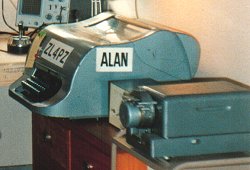 The picture shows my Creed Model 54 Teleprinter with the Creed 6S tape reader at right. [See separate Appendix] Briefly, the teleprinter was powered from the mains and interconnected to your radio equipment in such a way as to produce a signal that could be sent and received over radio. It was very cumbersome but quite exciting when you saw someone sending their greetings to you or calling CQ in a printed form. These devices were quite noisy in your radio shack and required that the door be closed to keep noise from the rest of the house who might be watching television. It was quite tedious sending the same information out from the keys to each person you contacted so very soon a means was found to do this automatically. Tape perforators and tape readers were soon made use of for repetitive operations such as sending out a CQ call or giving your station information. Some of the ideas used were quite ingenious with some operators sending out pictures made up from normal typewriter characters. Eventually after moving to Hawkes Bay I added a basic computer to this system which reduced the need to use the clunking teleprinter to send with. I still used the teleprinter for 'hard copy' as I had no printer for the computer in those days. Once proficient on this mode I had numerous contacts with more than forty different foreign countries and kept a separate folder for their QSL cards as they arrived either direct or via the NZART bureau. [See QSL & QSL Bureau in glossary of terms]. I've included some samples of RTTY art which we used to send/receive using the old mechanical printers and tape readers.
The picture shows my Creed Model 54 Teleprinter with the Creed 6S tape reader at right. [See separate Appendix] Briefly, the teleprinter was powered from the mains and interconnected to your radio equipment in such a way as to produce a signal that could be sent and received over radio. It was very cumbersome but quite exciting when you saw someone sending their greetings to you or calling CQ in a printed form. These devices were quite noisy in your radio shack and required that the door be closed to keep noise from the rest of the house who might be watching television. It was quite tedious sending the same information out from the keys to each person you contacted so very soon a means was found to do this automatically. Tape perforators and tape readers were soon made use of for repetitive operations such as sending out a CQ call or giving your station information. Some of the ideas used were quite ingenious with some operators sending out pictures made up from normal typewriter characters. Eventually after moving to Hawkes Bay I added a basic computer to this system which reduced the need to use the clunking teleprinter to send with. I still used the teleprinter for 'hard copy' as I had no printer for the computer in those days. Once proficient on this mode I had numerous contacts with more than forty different foreign countries and kept a separate folder for their QSL cards as they arrived either direct or via the NZART bureau. [See QSL & QSL Bureau in glossary of terms]. I've included some samples of RTTY art which we used to send/receive using the old mechanical printers and tape readers. 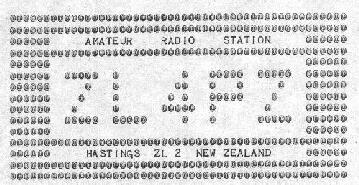 It was later also sent and received on RTTY by using home computers. The printout of my QSL card at the left was an actual printout received in Wellington by Bill ZL2AUG. He mailed it to me as proof of how good the copy was that night. Some 'art' was really good with shading accomplished by using a carriage return without doing a line feed. In this way you could 'type over' certain characters to give a darker colour. The one problem with RTTY reception was that unless conditions were very good you got errors appearing in your received text/picture. The RTTY system did not have error checking (checksums) as part of the system. Later modes of sending text/data over the radio included 'handshaking' between the sender's station and the receiver's station to see that each section of data was received correctly. This is accomplished by sending a checksum (data) at the end of each burst of information. If the main data did not equate to the checksum then a repeat was asked for and nothing appears on your screen till it all checks out OK.
It was later also sent and received on RTTY by using home computers. The printout of my QSL card at the left was an actual printout received in Wellington by Bill ZL2AUG. He mailed it to me as proof of how good the copy was that night. Some 'art' was really good with shading accomplished by using a carriage return without doing a line feed. In this way you could 'type over' certain characters to give a darker colour. The one problem with RTTY reception was that unless conditions were very good you got errors appearing in your received text/picture. The RTTY system did not have error checking (checksums) as part of the system. Later modes of sending text/data over the radio included 'handshaking' between the sender's station and the receiver's station to see that each section of data was received correctly. This is accomplished by sending a checksum (data) at the end of each burst of information. If the main data did not equate to the checksum then a repeat was asked for and nothing appears on your screen till it all checks out OK.
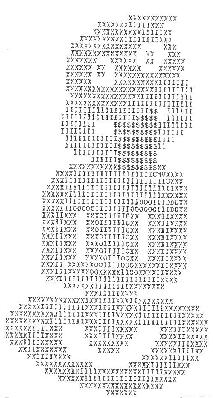
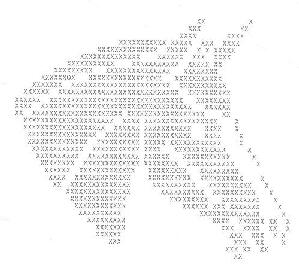 In the 'Tiki' at left, the top line of print is displaced to the right due to reception errors and the last two lines of the horses head likewise.
In the 'Tiki' at left, the top line of print is displaced to the right due to reception errors and the last two lines of the horses head likewise.
Having spent 11 years of my life in Central Otago it was good to eventually catch up with some of those in that area again via my hobby. Some who spring to mind are, Ron Murray ZL4MM, Kevin Hayes ZL4MD, Brian Williamson ZL4BW and Jim Colyer ZL4KE (King Edward). Jim was ex Post Office and lived in Alexandra. I called on him on the odd occasion and long after moving away from 'Central' he would comment "I've still got that TV set in the shack, and it's still going fine". I'd given him a heap of unwanted stuff from my Cromwell business when we moved back to Dunedin in 1977 and the black & white TV was amongst it. Sadly Jim passed away in 1992.
Contests were another event which brought amateurs together in a friendly way, even if on occasion we would 'pinch' someone else's frequency, unintentionally of course! MY first look at one of the local Branches National Field Days was I guess in 1979 when operators from our club went up the Northern motorway to the road that goes to Pigeon Flat. I recall a tent set up and one of the operators present was Ian Maslen ZL4DQ. I'm certain I didn't take any active part in proceedings on that occasion but field days from then on were something both Jeanne and myself got into boots and all.
About here I should mention that Jeanne suffered in silence on the times when I was sitting in the radio 'shack' looking for that rare station. In her wisdom she developed the attitude that "if you can't beat 'em, join 'em". She reckoned that if I was going to have some good dollars tied up in amateur radio equipment, then she might as well have her share of that too. She started attending classes at our club taken by Bill Black ZL4TGM and Bob Smith ZL4OC. That would have been in 1980 as that was the year we (I) decided to transfer North to Hastings with my employment of the time, Group Rentals [Televison Service Division].
Before moving North in 1980 I had been elected to our Branch committee at a time when Dunedin had been subjected to the shock of the Abbotsford disaster. On 5.30 pm 8th August 1979 Civil Defence was alerted to subsidence of the ground in the suburb of Abbotsford. 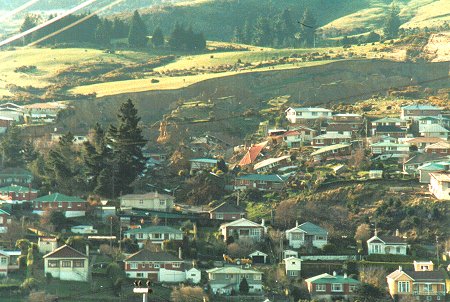 At 9.04 pm that evening the ground gave way and a number of houses slid down the hillside, in some cases taking people with them. As luck would have it nobody was killed and as far as I recall nobody was seriously injured if at all. I was one of those amateurs who was called on to assist with communications over that night till daybreak. Being dark when I arrived I had no idea of the damage that had occurred until I came out of the hut where we had been housed overnight. We were a matter of yards from the edge of the slip area. You could see this great gully with houses swept away down towards the motorway at the bottom of the hill. Just as well I didn't know how close we were to the edge during the night. The picture shows Abbotsford from the southern motorway the day after the slip. As a direct result of this disaster it was decided that our Branch start pushing for a mobile communications vehicle. This was well under way at the time we left Dunedin for Hastings and of course it did happen. The vehicle is a credit to those who sponsored it and to our Branch personnel including AREC officers who fitted it out for radio equipment. It has had a few improvements over the years having had a new motor and more recently a complete new chassis and cab. It has ample battery power to last many hours, plus a petrol generator to top up the batteries and also provide 230V 'mains' power if required.
At 9.04 pm that evening the ground gave way and a number of houses slid down the hillside, in some cases taking people with them. As luck would have it nobody was killed and as far as I recall nobody was seriously injured if at all. I was one of those amateurs who was called on to assist with communications over that night till daybreak. Being dark when I arrived I had no idea of the damage that had occurred until I came out of the hut where we had been housed overnight. We were a matter of yards from the edge of the slip area. You could see this great gully with houses swept away down towards the motorway at the bottom of the hill. Just as well I didn't know how close we were to the edge during the night. The picture shows Abbotsford from the southern motorway the day after the slip. As a direct result of this disaster it was decided that our Branch start pushing for a mobile communications vehicle. This was well under way at the time we left Dunedin for Hastings and of course it did happen. The vehicle is a credit to those who sponsored it and to our Branch personnel including AREC officers who fitted it out for radio equipment. It has had a few improvements over the years having had a new motor and more recently a complete new chassis and cab. It has ample battery power to last many hours, plus a petrol generator to top up the batteries and also provide 230V 'mains' power if required.
Another disaster where I was also involved with communications was the Taieri flooding. Amateur radio has been the backbone of maintaining communications during such disasters and is one of the ways amateurs provide community service.
In those days passing the morse gained you a 'Grade II' licence which entitled you to use the 80 and 160 metre bands. You were able to progress to a 'Grade I' licence only after you had been operating for 12 months, had 100 contacts and passed your morse test for a second time. The Radio Regulations in more recent times give amateurs access to ALL amateur frequencies after the initial passing of 12 wpm morse test. There is now no requirement for the second test.
I fronted up for my Grade I test on 5th December 1979, passing without difficulty as I had kept my hand in on a regular weekly CW sked with Barrie ZL3SM in Kaikoura. Barrie and I drifted off to our different activities after the 12 months had passed and we gained our Grade I licences, but we did keep in touch for a few years afterwards by way of Christmas cards or a call from time to time when heard on air. Jeanne and I stayed with Barrie and his family in Kaikoura a few times over the years that we were in the North Island when we were en route to Dunedin occasionally.
